
Saarbrücken Hauptbahnhof
Encyclopedia
Saarbrücken Hauptbahnhof (also: Eurobahnhof Saarbrücken) is the main or central railway station in the German city of Saarbrücken
and the largest station in the Saarland
, a German state on the border with France
. Around 10 million passengers use the station annually. The station is operated by DB Station&Service
as a category
2 station, served by regional and long-distance trains.
emerged later from the amalgamation of (old)Saarbrücken, St Johann, Malstatt and St. Arnual. The station was on the Saarbrücken railway, which ran from Bexbach via Neunkirchen (Saar) and Stieringen to the French Eastern Railway. The 56 metre long, 13.50 metre wide sandstone building was between the two tracks with access by an underpass, there being, unusually for that time, no track crossing.
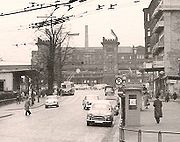
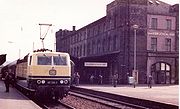 As the railway facilities continued to grow, so the station building was also enlarged. In 1891/1893 a station entrance building with two striking towers was erected in front of the tunnel, and in 1908 there were plans to build a completely new station building. This was to begin in 1914, but the outbreak of the First World War put paid to the plans. In 1932, Saarbrücken Hauptbahnhof handled 453 daily arrivals and departures, of which 51 were express train
As the railway facilities continued to grow, so the station building was also enlarged. In 1891/1893 a station entrance building with two striking towers was erected in front of the tunnel, and in 1908 there were plans to build a completely new station building. This was to begin in 1914, but the outbreak of the First World War put paid to the plans. In 1932, Saarbrücken Hauptbahnhof handled 453 daily arrivals and departures, of which 51 were express train
s, the second-largest number of trains on the Reichsbahn, after Leipzig. After the reannexation of the Saarland in 1935, plans for a new station restarted in earnest. This was to be completed by 1941, but again the war prevented them coming to fruition.
In the Second World War 80% of the railway facilities in Saarbrücken were destroyed. Of the entrance building only the two towers remained, and other buildings like the locomotive shed (Bahnbetriebswerk
) were totally destroyed. In the station yard there was not a single through track left. Under US direction, today's track 19 was provisionally restored. Over this track the US troops ran their supply trains towards Neunkirchen-Bexbach-Homburg under their own management and running on sight.
The two towers of the entrance building were linked in 1952 by a flat-roofed building and this formed a temporary structure for many years thereafter. In the 1960s fresh plans were made for a new reception and administrative building. The first sod was turned on 27 June 1963 by the Mayor of Saarbrücken, Fritz Schuster, and the President of the Bundesbahn railway division, Alois Meyer. In the same year the remains of the old entrance building were removed. In September 1967 the new 120-metre-long, 26-metre-high building was inaugurated. On the two-storey-high ground floor were the main hall, luggage check-in, shops and a restaurant; on the upper floors of the seven-storey building were the computer centre, medical services, offices and staff canteen.
In February 1960 electric train services began on the Forbach
-Homburg
.
In 1977 work on a thorough modernisation was begun. Amongst other things the platforms were raised to a height of 760 mm. In order to create space for more through tracks, the first station building from 1852, the so-called 'island building', was demolished between 18 September 1978 and March 1979.
 The Eurobahnhof (or Eurostation) is the name for the Saarbrücken 21 project to modernise the Hauptbahnhof. The existing station and surrounding land was rebuilt. In June 2007 an important milestone during the work was passed with the opening of the Paris-Eastern France-Southern Germany (POS) high-speed route, with its branches to Stuttgart
The Eurobahnhof (or Eurostation) is the name for the Saarbrücken 21 project to modernise the Hauptbahnhof. The existing station and surrounding land was rebuilt. In June 2007 an important milestone during the work was passed with the opening of the Paris-Eastern France-Southern Germany (POS) high-speed route, with its branches to Stuttgart
and Frankfurt
, the latter from Saarbrücken.
Key changes included a new southern façade for the station building, a newly-designed entrance hall and pedestrian underpass, new lifts and a new access to the station from the north from the district of Rodenhof. The costs of about €31 million were divided between the state capital of Saarbrücken, the Saarland and Deutsche Bahn AG.
The extensive network of tracks north of the station was largely removed; east of the station tracks were relaid in a different layout and modernised. New train maintenance and storage facilities were constructed within a relatively compact space. The area freed up is intended to be used for car parking and a new industrial estate, the "Eurostation Estate" or Quartier Eurobahnhof. The construction of access roads to the site and attracting business are proving to be protracted processes, and will take a long time yet. The large Servicepoint (tickets and catering) set up by DB AG at the north entrance was closed after a short time due to lack of customers.
The first sod was tured on 5 May 2006 and the official opening ceremony of the modernised station took place on 15 December 2007. A year later, however, the station was still not ready; containerised shops and building materials cluttered the station forecourt, and rats were also frequently seen there, much to the consternation of the local population and passengers.
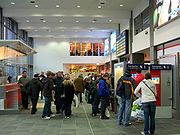 Now that it has become a Eurostation, the Hauptbahnhof opens onto the city and the pedestrian zone (Reichsstrasse/Bahnhofstrasse) via a large reception hall. This has rows of shops on two floors which sell everyday fare and popular goods. The shops include a supermarket, fast-food restaurant, newsagents and stationers, tobacconists, florists and more), the DB Service Point, the DB/Ameropa travel centre and a terminal with DB ticket machines.
Now that it has become a Eurostation, the Hauptbahnhof opens onto the city and the pedestrian zone (Reichsstrasse/Bahnhofstrasse) via a large reception hall. This has rows of shops on two floors which sell everyday fare and popular goods. The shops include a supermarket, fast-food restaurant, newsagents and stationers, tobacconists, florists and more), the DB Service Point, the DB/Ameropa travel centre and a terminal with DB ticket machines.
In front of the city entrance is the large station forecourt, mostly traffic-free, numerous bicycle stands and the four-track Hauptbahnhof tram stop of the Saarbrücken Stadtbahn
(Saarbahn), from which runs290 services per day to France/Kleinblittersdorf/Südstadt/Innenstadt and Riegelsberg/Nordstadt. Hundreds of town and regional buses also stop here.
All the platforms are barrier-free and apart from platforms 1-3 are each accessible by lift, escalator and stairs; platforms 1-3 are accessible by staircase and lift.
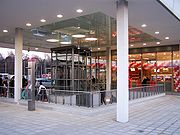 Together with the renovation and rebuilding work as part of the Saarbrücken 21 (Eurobahnhof) project, the pedestrian tunnel, which previously ended at platform 16, and to about 2001 at platform 22, was extended into the district of Rodenhof. There a new entrance was built, the North Terminal, which connects to a new Park & Ride area with several hundred spaces; a direct connexion to the Ludwigsbergkreisel and from there to the A 1, A 620
Together with the renovation and rebuilding work as part of the Saarbrücken 21 (Eurobahnhof) project, the pedestrian tunnel, which previously ended at platform 16, and to about 2001 at platform 22, was extended into the district of Rodenhof. There a new entrance was built, the North Terminal, which connects to a new Park & Ride area with several hundred spaces; a direct connexion to the Ludwigsbergkreisel and from there to the A 1, A 620
and A 623
motorways is planned. If required the DB-Servicepoint may be opened again.
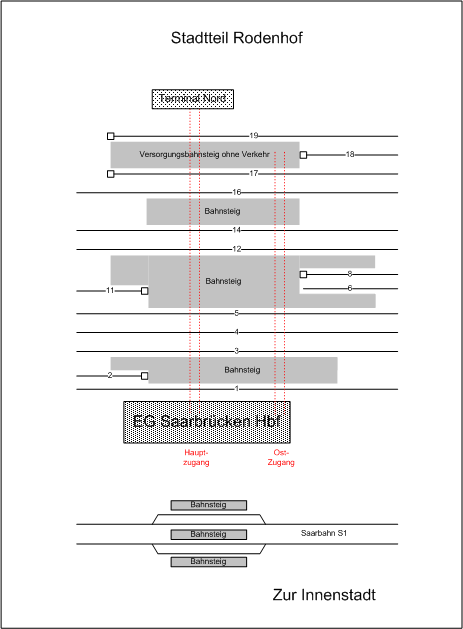 The platforms (apart from the tram lines in front of the City entrance) are about 20 metres above the pedestrian tunnel that links the two station entrances. The tracks are numbered 1–16, of which only ten are used for passenger trains; these are numbers 1-3, 5-6, 8, 11-12, 14 and 16. The other tracks are for other railway operations or no longer exist. Amongst the ten tracks used for passenger services are six through tracks, that are used by trains passing through Saarbrücken, and four bay platforms (2, 6, 8, 11), at which train services begin or terminate.
The platforms (apart from the tram lines in front of the City entrance) are about 20 metres above the pedestrian tunnel that links the two station entrances. The tracks are numbered 1–16, of which only ten are used for passenger trains; these are numbers 1-3, 5-6, 8, 11-12, 14 and 16. The other tracks are for other railway operations or no longer exist. Amongst the ten tracks used for passenger services are six through tracks, that are used by trains passing through Saarbrücken, and four bay platforms (2, 6, 8, 11), at which train services begin or terminate.

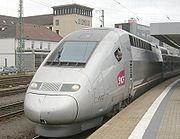 Since December 2007 Saarbrücken Hbf has been on the German high-speed railway network and an arrival and departure gateway for the cross-border ICE trains between Paris
Since December 2007 Saarbrücken Hbf has been on the German high-speed railway network and an arrival and departure gateway for the cross-border ICE trains between Paris
and Frankfurt. In addition, long-distance trains run to Dresden
, Stuttgart
and Salzburg
.
Trams run every 7.5 minutes on the inner city line between Brebach and Siedlerheim in both directions, every 15 minutes to Kleinblittersdorf and Riegelsberg-Süd and every 30 minutes to Saargemünd.
Occasionally the Messe line runs services to exhibitions or special events at the exhibition centre (Messezentrum) in Saarbrücken (the last occasion was German Catholic Day in 2006).
Saarbrücken
Saarbrücken is the capital of the state of Saarland in Germany. The city is situated at the heart of a metropolitan area that borders on the west on Dillingen and to the north-east on Neunkirchen, where most of the people of the Saarland live....
and the largest station in the Saarland
Saarland
Saarland is one of the sixteen states of Germany. The capital is Saarbrücken. It has an area of 2570 km² and 1,045,000 inhabitants. In both area and population, it is the smallest state in Germany other than the city-states...
, a German state on the border with France
France
The French Republic , The French Republic , The French Republic , (commonly known as France , is a unitary semi-presidential republic in Western Europe with several overseas territories and islands located on other continents and in the Indian, Pacific, and Atlantic oceans. Metropolitan France...
. Around 10 million passengers use the station annually. The station is operated by DB Station&Service
DB Station&Service
DB Station&Service is a subsidiary of Deutsche Bahn AG, responsible for managing over 5,000 stations on the German railway network....
as a category
German railway station categories
About 5,400 railway stations in Germany that are owned and operated by the Deutsche Bahn subsidiary DB Station&Service are assigned into seven categories, denoting the service level available at the station....
2 station, served by regional and long-distance trains.
History
Saarbrücken's main station was opened on 16 November 1852 as St Johann-Saarbrücken. The present city of SaarbrückenSaarbrücken
Saarbrücken is the capital of the state of Saarland in Germany. The city is situated at the heart of a metropolitan area that borders on the west on Dillingen and to the north-east on Neunkirchen, where most of the people of the Saarland live....
emerged later from the amalgamation of (old)Saarbrücken, St Johann, Malstatt and St. Arnual. The station was on the Saarbrücken railway, which ran from Bexbach via Neunkirchen (Saar) and Stieringen to the French Eastern Railway. The 56 metre long, 13.50 metre wide sandstone building was between the two tracks with access by an underpass, there being, unusually for that time, no track crossing.


Express train
Express trains are a form of rail service. Express trains make only a small number of stops, instead of stopping at every single station...
s, the second-largest number of trains on the Reichsbahn, after Leipzig. After the reannexation of the Saarland in 1935, plans for a new station restarted in earnest. This was to be completed by 1941, but again the war prevented them coming to fruition.
In the Second World War 80% of the railway facilities in Saarbrücken were destroyed. Of the entrance building only the two towers remained, and other buildings like the locomotive shed (Bahnbetriebswerk
Bahnbetriebswerk
A Bahnbetriebswerk is the equivalent of a locomotive depot on the German and Austrian railways. It is an installation that carries out the maintenance, minor repairs, refuelling and cleaning of locomotives and other motive power. In addition it organises the deployment of locomotives and crews...
) were totally destroyed. In the station yard there was not a single through track left. Under US direction, today's track 19 was provisionally restored. Over this track the US troops ran their supply trains towards Neunkirchen-Bexbach-Homburg under their own management and running on sight.
The two towers of the entrance building were linked in 1952 by a flat-roofed building and this formed a temporary structure for many years thereafter. In the 1960s fresh plans were made for a new reception and administrative building. The first sod was turned on 27 June 1963 by the Mayor of Saarbrücken, Fritz Schuster, and the President of the Bundesbahn railway division, Alois Meyer. In the same year the remains of the old entrance building were removed. In September 1967 the new 120-metre-long, 26-metre-high building was inaugurated. On the two-storey-high ground floor were the main hall, luggage check-in, shops and a restaurant; on the upper floors of the seven-storey building were the computer centre, medical services, offices and staff canteen.
In February 1960 electric train services began on the Forbach
Forbach
Forbach is a commune in the Moselle department in Lorraine in north-eastern France.It is located near the German border. Population : 22,784....
-Homburg
Homburg
-In Germany:* Homburg, Saarland, capital of the Saarpfalz district of Saarland* Bad Homburg, town and spa in Hesse* Homburg Forest, a hill range in Lower Saxony* Homburg, a quarter of Triefenstein, Bavaria...
.
In 1977 work on a thorough modernisation was begun. Amongst other things the platforms were raised to a height of 760 mm. In order to create space for more through tracks, the first station building from 1852, the so-called 'island building', was demolished between 18 September 1978 and March 1979.
Saarbrücken 21

Stuttgart
Stuttgart is the capital of the state of Baden-Württemberg in southern Germany. The sixth-largest city in Germany, Stuttgart has a population of 600,038 while the metropolitan area has a population of 5.3 million ....
and Frankfurt
Frankfurt
Frankfurt am Main , commonly known simply as Frankfurt, is the largest city in the German state of Hesse and the fifth-largest city in Germany, with a 2010 population of 688,249. The urban area had an estimated population of 2,300,000 in 2010...
, the latter from Saarbrücken.
Key changes included a new southern façade for the station building, a newly-designed entrance hall and pedestrian underpass, new lifts and a new access to the station from the north from the district of Rodenhof. The costs of about €31 million were divided between the state capital of Saarbrücken, the Saarland and Deutsche Bahn AG.
The extensive network of tracks north of the station was largely removed; east of the station tracks were relaid in a different layout and modernised. New train maintenance and storage facilities were constructed within a relatively compact space. The area freed up is intended to be used for car parking and a new industrial estate, the "Eurostation Estate" or Quartier Eurobahnhof. The construction of access roads to the site and attracting business are proving to be protracted processes, and will take a long time yet. The large Servicepoint (tickets and catering) set up by DB AG at the north entrance was closed after a short time due to lack of customers.
The first sod was tured on 5 May 2006 and the official opening ceremony of the modernised station took place on 15 December 2007. A year later, however, the station was still not ready; containerised shops and building materials cluttered the station forecourt, and rats were also frequently seen there, much to the consternation of the local population and passengers.
Reception Hall/ City Entrance

In front of the city entrance is the large station forecourt, mostly traffic-free, numerous bicycle stands and the four-track Hauptbahnhof tram stop of the Saarbrücken Stadtbahn
Stadtbahn
A ' is a tramway or light railway that includes segments built to rapid transit standards, usually as part of a process of conversion to a metro railway, mainly by the building of tunnels in the central city area....
(Saarbahn), from which runs290 services per day to France/Kleinblittersdorf/Südstadt/Innenstadt and Riegelsberg/Nordstadt. Hundreds of town and regional buses also stop here.
Pedestrian tunnel / Lower level
All 16 platforms are accessible via the fully renovated pedestrian tunnel and via the Osttunnel. This is about 100 metres long and climbs gently from the City entrance hall to the new North entrance in the district of Rodenhof, and is decorated in plain blue and white shades of colour.All the platforms are barrier-free and apart from platforms 1-3 are each accessible by lift, escalator and stairs; platforms 1-3 are accessible by staircase and lift.
North terminal / Rodenhof north exit

Bundesautobahn 620
is an autobahn in Germany, connecting Saarlouis with Saarbrücken. Together with the A 6, it serves as part of the connection between Luxembourg and Germany. As the mayor part of the BAB 620 is alongside the river Saar, one section in Saarbrücken, the so-called "Stadtautobahn" is subject...
and A 623
Bundesautobahn 623
is an autobahn in Germany.The A 623 is a spur connecting the A 8 to Saarbrücken. As with the A 1 to the west, the A 623 does not actually enter the inner city. Connections to arteries into Saarbrücken are made at the final two junctions. Junction 7 offers a connection to the...
motorways is planned. If required the DB-Servicepoint may be opened again.
Platforms

Long-distance services


Paris
Paris is the capital and largest city in France, situated on the river Seine, in northern France, at the heart of the Île-de-France region...
and Frankfurt. In addition, long-distance trains run to Dresden
Dresden
Dresden is the capital city of the Free State of Saxony in Germany. It is situated in a valley on the River Elbe, near the Czech border. The Dresden conurbation is part of the Saxon Triangle metropolitan area....
, Stuttgart
Stuttgart
Stuttgart is the capital of the state of Baden-Württemberg in southern Germany. The sixth-largest city in Germany, Stuttgart has a population of 600,038 while the metropolitan area has a population of 5.3 million ....
and Salzburg
Salzburg
-Population development:In 1935, the population significantly increased when Salzburg absorbed adjacent municipalities. After World War II, numerous refugees found a new home in the city. New residential space was created for American soldiers of the postwar Occupation, and could be used for...
.
| Type | Route No. | Route | Frequency |
|---|---|---|---|
| 50 | Saarbrücken-Mannheim-Frankfurt-Fulda-Dresden | single trains | |
| 82 | Saarbrücken-Mannheim-Frankfurt | 5x daily | |
| 82 | Saarbrücken-Paris | 5x daily | |
 |
50 | Saarbrücken-Mannheim-Frankfurt | 2x daily |
 |
62 | Saarbrücken-Mannheim-Stuttgart(-Munich-Salzburg) | 3x daily |
Local services
Saarbrücken Hauptbahnhof is the main hub for regional railway services in the Saarland. With few exceptions, Saarland local services begin and terminate at Saarbrücken Hbf.| Route No. | Route | Frequency |
|---|---|---|
| Saarbrücken-Völklingen-Saarlouis-Merzig-Trier-Koblenz | two-hourly | |
| Saarbrücken-Neunkirchen-Türkismühle-Mainz | hourly | |
| Saarbrücken-Völklingen-Saarlouis-Merzig-Trier | two-hourly | |
| Saarbrücken-Forbach-Metz | hourly (with gaps) | |
| Saarbrücken-Saargemünd-Strasbourg | single trains | |
| Saarbrücken-St. Ingbert-Homburg-Kaiserslautern | hourly | |
| Saarbrücken-St. Ingbert-Zweibrücken-Pirmasens | hourly | |
| Homburg-St. Ingbert-Saarbrücken-Völklingen-Saarlouis-Merzig-Trier | hourly | |
| Saarbrücken-Illingen-Lebach | hourly | |
| Saarbrücken-Neunkirchen-St. Wendel-(Türkismühle) | half-hourly/hourly | |
| (Illingen-Wemmetsweiler)-Neunkirchen-Homburg | half-hourly/hourly | |
| Saarbrücken-Wemmetsweiler-Neunkirchen-Homburg | single trains |
Stadtbahn services
The Stadtbahn lines of the Saarbrücken transport company Saarbahn&Bus run from the four tram platforms on the station forecourt| Route No. | Route | Frequency |
|---|---|---|
| Hauptbahnhof-Rathaus-Römerkastell-Brebach | 15 min. | |
| Hauptbahnhof-Rathaus-Römerkastell-Brebach-Kleinblittersdorf | 30 min. | |
| Hauptbahnhof-Rathaus-Römerkastell-Brebach-Saargemünd | 30 min. | |
| Hauptbahnhof-Rastpfuhl-Siedlerheim | 15 min. | |
| Hauptbahnhof-Rastpfuhl-Siedlerheim-Riegelsberg Süd | 15 min. |
Trams run every 7.5 minutes on the inner city line between Brebach and Siedlerheim in both directions, every 15 minutes to Kleinblittersdorf and Riegelsberg-Süd and every 30 minutes to Saargemünd.
Occasionally the Messe line runs services to exhibitions or special events at the exhibition centre (Messezentrum) in Saarbrücken (the last occasion was German Catholic Day in 2006).
| Route No. | Route | Frequency |
|---|---|---|
| Hauptbahnhof-Messebahnhof | 30 min. | |
| Hauptbahnhof-Rathaus-Römerkastell | 30 min. |
Sources
- Ankunft Saarbrücken Hbf, (150 Jahre Eisenbahn an der Saar), Herausg. Staatskanzlei, Saarbrücken 2002, ISBN 3-9808556-0-0
External links
- Detailed article on the European Business Network
- Project page of the GIU (Gesellschaft für Innovation und Unternehmensförderung)
- Eurostation estate (Quartier Eurobahnhof)
- There is a relevant English-language forum at Railways of Germany

